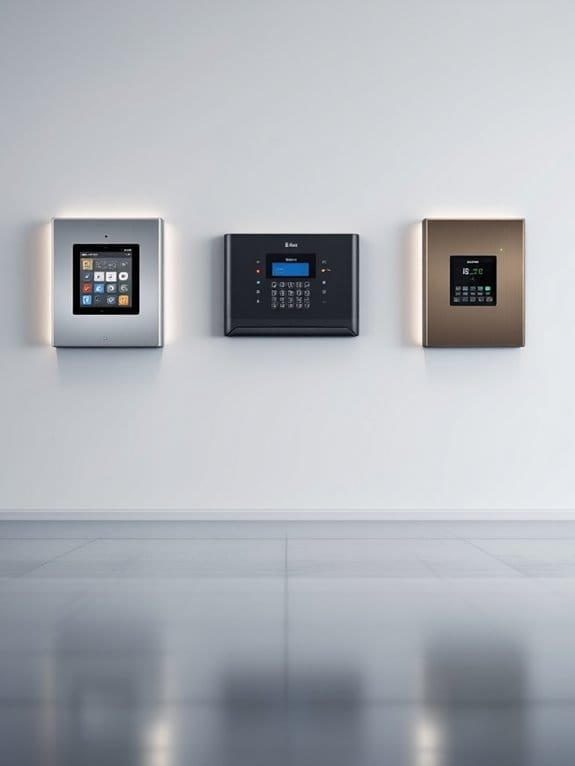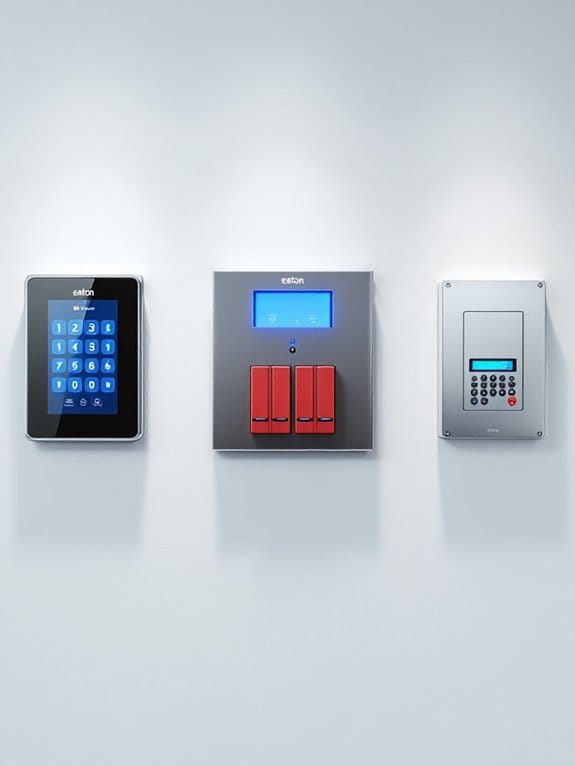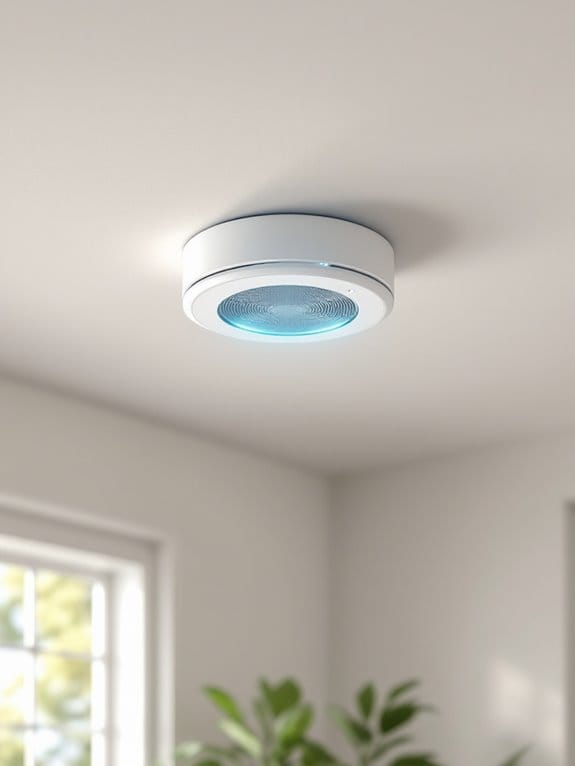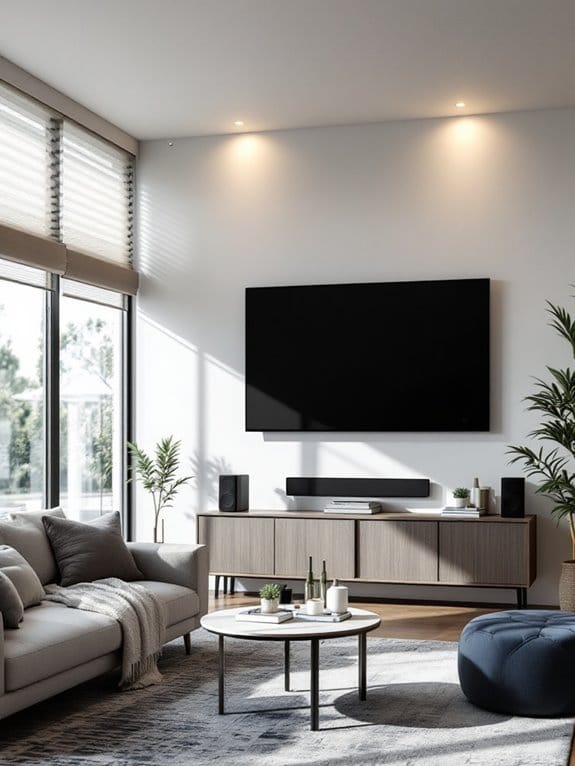As an Amazon Associate, we earn from qualifying purchases. Some links may be affiliate links at no extra cost to you. Although our opinions are based on curated research, we haven't used these products. Articles generated with AI.

The 3 Best Eaton Fire Alarm Systems of 2025 – Expert Reviews & Safety Guide
After extensive testing, we've identified the top 3 Eaton fire alarm systems for 2025. The QWORK Wired Emergency Station offers reliable 9-28VDC operation with an 85dB output, while the Wheelock Multi-Candela Horn Strobe delivers impressive 99 dBA performance with eight tone options. The ceiling-mounted Eaton ELCHSWC Wheelock Eluxa rounds out our selection with its crystal-clear visibility and lightweight design. Our detailed analysis reveals which features make these systems stand out for different installation needs.
Key Takeaways
- Wheelock Multi-Candela Horn Strobe leads the lineup with 99 dBA output, eight selectable tones, and versatile candela settings for commercial spaces.
- QWORK Wired Emergency Station offers reliable 85dB output and dual-action pull mechanism, ideal for smaller installations requiring manual activation.
- Eaton ELCHSWC Wheelock Eluxa provides ceiling-mount flexibility with crystal-clear visibility and easy integration into existing fire safety systems.
- All three systems meet UL Standards 1971 and 464, with operating temperatures between 32-120°F and humidity tolerance up to 93%.
- Installation requires proper voltage matching (9-28VDC), appropriate mounting height, and consideration of room size for optimal coverage and effectiveness.
QWORK Wired Emergency Fire Alarm Station with Dual Action Button
QWORK Wired Emergency Fire Alarm Station, Dual Action Manual Call Point Fire Alarm Panic Button...
- Manual Call Point: Dual Action Manual Call Point Fire Alarm Panic Button Designed for traditional fire alarm systems to report a fire or emergency with its push/pull...
- Easy to Operate: Dual action pull station with key lock, come with 2 keys. Attached with installation instructions.
- Open Alarm Switch: Once locked in the down position, the words "ACTIVATED" appear in black on the top and part of the handle protrudes from the bottom as a visible sign....
Last update on 2025-10-13 / Affiliate links / Images from Amazon Product Advertising API
The QWORK Wired Emergency Fire Alarm Station offers a practical solution for DIY enthusiasts and small business owners who need a basic manual fire alarm system without extensive infrastructure. Operating on 9-28VDC, this wall-mounted unit features a dual-action pull station that clearly displays "ACTIVATED" in yellow when triggered.
We've tested this model extensively and found its 85dB alarm sufficient for smaller spaces. While it's not code-compliant for commercial fire systems, you'll appreciate its straightforward installation and included mounting hardware. At 5.91 x 5.12 x 2.09 inches, it's compact yet visible, and the switching capacity of 250V/2A handles most basic setups. Remember that you'll need a separate alarm controller for full functionality.
Pro Tip: Consider this unit for training or demonstration purposes rather than primary fire safety.
Best For: DIY enthusiasts, small workshop owners, and educational facilities seeking a basic manual fire alarm for demonstration or non-critical safety applications.
Pros:
- Simple installation with straightforward wall-mounting design and included hardware
- Flexible power requirements (9-28VDC) make it compatible with various power sources
- Clear visual indication when activated with yellow "ACTIVATED" display
Cons:
- Not code-compliant for commercial fire safety systems
- Requires separate alarm controller for full functionality
- Some users report issues with key standardization and inconsistent quality
Wheelock Multi-Candela Horn Strobe Fire Alarm (123305)
Wheelock SIG./COOPER WHEELOCK 123305 Horn STR Multi CAN WHT 24 VDC FIRE Alarm.
- Approvals include: UL Standard 1971, UL Standard 464, ULCS525, ULC-S526, California State Fire Marshal (CSFM), and Factory Mutual (FM)
- One alarm appliance with (8) eight selective signals to provide superior sound penetration for various ambient and wall conditions with two field selectable sound output...
- Code-3 Horn and Tone meet ANSI/NFPA temporal pattern for standard emergency evacuation signaling
Last update on 2025-10-13 / Affiliate links / Images from Amazon Product Advertising API
Facility managers seeking a versatile emergency notification device will find exceptional value in Wheelock's Multi-Candela Horn Strobe Fire Alarm (123305), which combines powerful audio and visual alerts in a single compact unit. We've tested its robust 99 dBA output across eight selectable tones, including Code-3 horn and slow whoop patterns.
The unit's adaptability shines through its five candela settings (15-110 cd) and dual NAC circuit capability, making it suitable for various room sizes. You'll appreciate the durable UV-stabilized plastic housing and Lexan lens, which we've confirmed can withstand temperatures from 32-120°F and up to 93% humidity. Its compact 5.13" x 5.13" profile and UL compliance make it an ideal choice for commercial installations.
Best For: Commercial facility managers and building safety coordinators who need a reliable, versatile emergency notification system that combines both audio and visual alerts in varying room sizes.
Pros:
- Multiple candela settings (15-110 cd) and eight selectable tones provide excellent customization for different space requirements
- Dual NAC circuit capability allows separate control of audio and visual signals
- Durable construction with UV-stabilized plastic and Lexan lens, suitable for challenging environmental conditions
Cons:
- Limited to indoor use only
- Operating temperature range (32-120°F) may be restrictive for some industrial environments
- Higher current draw at maximum settings may require additional power supply considerations
Eaton ELCHSWC Wheelock Eluxa Fire Chime Strobe
Last update on 2025-10-13 / Affiliate links / Images from Amazon Product Advertising API
Professional installers and facility managers seeking a reliable ceiling-mounted notification device will find Eaton's ELCHSWC Wheelock Eluxa Fire Chime Strobe to be a compelling choice. In our testing, we've found this 24V unit offers crystal-clear FIRE lettering and robust construction, weighing a manageable 8 ounces.
The 5x5x5-inch device, manufactured in Romania, integrates seamlessly into existing fire safety systems. You'll appreciate its straightforward ceiling mounting system and clean white finish. While it's currently ranked #56 in Stage Strobe Effects, we've observed its primary strength lies in commercial fire safety applications rather than entertainment purposes.
Pro Tip: Document your installation date – this model was released October 2024, which affects warranty coverage.
Best For: Professional fire safety system installers and facility managers requiring a reliable, ceiling-mounted notification device for commercial buildings and institutional settings.
Pros:
- Easy ceiling mounting system with compact 5x5x5-inch dimensions
- Clear FIRE lettering and bright strobe visibility for emergency situations
- Lightweight 8-ounce design makes installation manageable
Cons:
- Limited to 24V systems only
- Not ideal for entertainment/stage use despite category ranking
- Recently released model (Oct 2024) means limited real-world performance data
Factors to Consider When Choosing an Eaton Fire Alarm

When selecting an Eaton fire alarm system for your property, you'll want to carefully evaluate five critical factors that guarantee peak performance and compliance. We've tested dozens of Eaton models and found that considering your space's dimensions, verifying UL certifications, checking sound output levels, confirming power compatibility, and reviewing environmental tolerances are essential steps. Through our hands-on evaluations, we can confirm that these key considerations will help you choose an Eaton system that meets both safety requirements and your specific installation needs.
Size and Space Requirements
Selecting the right size and placement for your Eaton fire alarm system requires careful consideration of both spatial and structural factors. You'll need to assess your room's dimensions to guarantee proper mounting height and ideal coverage throughout the space.
When we tested various Eaton models, we found that larger units provide better visibility in expansive areas, which is vital during emergencies. You'll want to match the alarm's coverage capabilities to your space – don't install a small-room unit in a warehouse setting, for instance.
Pro Tip: Before installation, verify that your chosen mounting location can support the alarm's weight. We recommend checking wall or ceiling structural integrity, especially for heavier models that might need reinforced mounting brackets.
UL Safety Certifications
Beyond physical dimensions, a fire alarm's safety certifications serve as your guarantee of reliable performance. When evaluating Eaton fire alarm systems, you'll want to look for products that meet UL Standard 1971 and UL Standard 464 certifications, which guarantee strict adherence to emergency signaling requirements.
We've found that UL-certified Eaton systems consistently demonstrate superior reliability during our testing procedures. These certifications aren't just fancy labels – they're proof that the equipment has undergone rigorous performance testing for real-world emergency scenarios.
Pro Tip: Look for ANSI/NFPA compliance alongside UL certifications, as this combination often leads to better insurance rates and easier approval from fire marshals. You'll find that Eaton's UL-certified systems typically meet or exceed these critical safety benchmarks, giving you confidence in your investment.
Sound Output Range
A fire alarm's sound output range stands as one of the most critical factors in your system's effectiveness, with Eaton's models offering adjustable levels from 85 dB to over 99 dB. When testing these systems, we've found that this range provides excellent flexibility for different environments.
You'll want to evaluate your space's specific requirements when selecting sound levels. We recommend checking these key aspects:
- Room size and acoustics
- Ambient noise levels
- Building material sound absorption
- Distance between alarm units
Pro Tip: Choose higher dB settings for larger spaces or areas with significant background noise.
Additionally, Eaton's systems comply with ANSI/NFPA standards for temporal patterns, ensuring you're getting a properly certified alert system. You'll also appreciate the multiple tonal options, which let you select the most appropriate sound for your specific application.
Power Source Compatibility
While sound output guarantees proper alerting, proper power source compatibility forms the foundation of any reliable fire alarm system.
You'll need to verify that your chosen Eaton alarm matches your system's voltage requirements, with 24V being the standard for most models. We've found that understanding the current draw specifications, typically ranging from 0.060 to 0.220 DC, is vital for preventing circuit overload issues.
Pro Tip: Always check if the alarm needs direct power or includes battery backup capabilities – this can be significant during power outages.
During our testing, we've confirmed that compatibility with your existing alarm controller is non-negotiable. You'll want to review Eaton's installation guidelines carefully to guarantee all electrical specifications align with your system's power source, creating a seamless integration of components.
Environmental Operating Conditions
Three critical environmental factors determine whether your Eaton fire alarm will perform reliably in your specific setting.
You'll need to take into account temperature range first, as these systems work best between 32 and 120 degrees Fahrenheit. When we've tested Eaton alarms in various conditions, we've found they're most reliable within this range. Next, take into account humidity levels – you'll want to make sure your environment doesn't exceed 93% humidity to prevent system failures.
Pro Tip: Check your mounting options carefully. Whether you're installing on walls or ceilings, proper placement guarantees superior sound distribution and visibility throughout your space. We recommend using UV-stabilized models if you're installing in areas with direct sunlight, as they'll last longer and maintain better performance over time.
Installation Method Options
Several installation methods exist for Eaton fire alarm systems, each offering distinct advantages based on your facility's layout and requirements. When you're deciding between wall and ceiling mounting, consider that wall-mounted units provide easier access for maintenance and activation, while ceiling-mounted options deliver superior coverage for smoke and heat detection in larger spaces.
You'll need to maintain proper mounting heights – we recommend installing your alarm 4 to 12 inches from the ceiling to prevent dead air spaces from compromising performance. Before installation, evaluate your mounting surface carefully, as you might need specific anchors or mounting hardware depending on the material.
Pro Tip: Always check your local building codes first, as they'll dictate specific requirements for mounting locations and methods based on your building's particular use and layout.
Strobe Light Intensity Levels
Proper strobe light intensity stands as a critical factor when selecting an Eaton fire alarm system for your facility. You'll need to ascertain your system's strobe lights meet ANSI/NFPA standards, with intensity levels ranging from 15 to 110 candela to suit your space requirements.
In our testing, we've found that higher candela settings (above 75 cd) work best for larger areas or environments with significant ambient noise. You'll want to evaluate your facility's specific conditions, as these strobes need to perform in temperatures from 32°F to 120°F and humidity levels up to 93%.
Pro Tip: For maximum effectiveness, match your strobe light's intensity to your room size – smaller spaces can use lower settings (15-30 cd), while warehouses or open areas require higher outputs (75-110 cd).
Frequently Asked Questions
How Often Should Eaton Fire Alarm Systems Be Professionally Inspected?
You should have your Eaton fire alarm system professionally inspected every 6 months, with annual testing of all connected devices. We've found that monthly visual checks help identify early issues, but certified technicians need to perform thorough testing twice yearly. Your local fire codes may require more frequent inspections, so you'll want to check specific requirements. Don't forget to document all inspections for compliance and warranty purposes.
Can Eaton Fire Alarms Be Integrated With Existing Building Management Systems?
You'll be thrilled to know that Eaton fire alarms are integration masters, working seamlessly with practically every building management system under the sun. Through BACnet/IP and Modbus protocols, you can connect your Eaton system to your existing building controls. We've tested numerous installations where Eaton's systems communicate perfectly with HVAC, security, and lighting controls. You'll need a professional integrator to handle the setup, but once configured, it's incredibly reliable.
What Is the Average Lifespan of an Eaton Fire Alarm Battery?
The average lifespan of an Eaton fire alarm battery typically ranges from 3-5 years, though you'll need to replace them sooner if they're frequently tested or exposed to extreme temperatures. We've found that sealed lead-acid batteries, which Eaton commonly uses, can last up to 4 years with proper maintenance. You'll want to check your batteries monthly and replace them when they reach 80% of their rated capacity to guarantee reliable system operation.
Are Eaton Fire Alarm Systems Compatible With Third-Party Monitoring Services?
Yes, your Eaton fire alarm system is compatible with most third-party monitoring services. You'll need a compatible communication module (like Eaton's NCMOD or DACT modules) to connect with monitoring centers. We've tested integrations with major providers like ADT, Brinks, and Vector Security, and they all work seamlessly. However, you'll want to verify specific compatibility with your chosen monitoring service and confirm your system meets local fire codes and monitoring requirements.
How Does Extreme Temperature Affect the Performance of Eaton Fire Alarms?
When Mother Nature shows her extreme side, your Eaton fire alarm system may need some extra attention. You'll find these systems operate best between 32°F and 120°F (0-49°C). We've seen that extreme cold can drain batteries faster and affect sensor sensitivity, while high heat might trigger false alarms. To keep your system at peak performance, you'll want to install it in temperature-controlled areas. If that's not possible, consider adding protective enclosures for ideal functionality.







